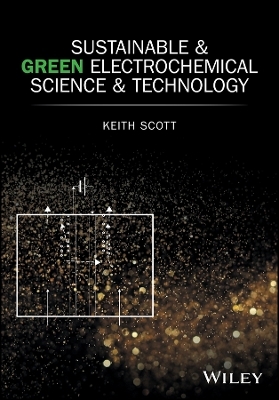
Sustainable and Green Electrochemical Science and Technology
John Wiley & Sons Inc (Hersteller)
978-1-118-69807-5 (ISBN)
- Keine Verlagsinformationen verfügbar
- Artikel merken
Sustainable and Green Electrochemical Science and Technology brings together the basic concepts of electrochemical science and engineering and shows how these are applied in an industrial context, emphasising the major role that electrochemistry plays within society and industry in providing cleaner, greener and more sustainable technologies. Electrochemistry has many applications for sustainability; it can be used to store energy, synthesise materials and chemicals, to generate power and to recycle valuable resources. Coverage includes * Electrochemistry, Electrocatalysis and Thermodynamics * Electrochemical Cells, Materials and Reactors * Carbon Dioxide Reduction and Electro-Organic Synthesis * Hydrogen production and Water Electrolysis * Inorganic Synthesis * Electrochemical Energy Storage and Power Sources * Electrochemical processes for recycling and resource recovery * Fuel Cell Technologies This book is targeted at both industrial and academic readers, providing a good technological reference base for electrochemistry. It will enable the reader to build on basic principles of electrochemistry, and takes these through to cell design for various and diverse applications.
KEITH SCOTT School of Chemical Engineering and Advanced Materials, Newcastle University, UK
Preface xiii Acknowledgement xv 1 Introduction to Electrochemical Sustainable Processes 1 1.1 Introduction 1 1.2 Effluent Treatment and Recycling 3 1.3 Green Electrochemistry 3 1.4 Electrochemistry and Energy Sustainability 4 1.5 Hydrogen Economy and Fuel Cells 7 1.5.1 The Hydrogen Economy 7 1.5.1.1 Hydrogen Generation, Storage and Use 10 1.5.2 Fuel Cells 22 1.6 Conclusions 24 References 25 2 Electrochemistry, Electrocatalysis and Thermodynamics 27 2.1 The Electrochemical Cell 27 2.1.1 Faraday s Law 29 2.2 Electrochemical Thermodynamics 29 2.2.1 Gibbs Free Energy 29 2.2.2 Free Energy and Equilibrium Constants 30 2.2.3 Free Energy and Cell Potentials 31 2.2.3.1 Cell Potential versus pH Diagrams 35 2.3 Types of Electrochemical Reactions 38 2.3.1 Electric Double Layer 39 2.3.2 Electrochemical Reaction 40 2.3.3 Electrochemical Kinetics 43 2.3.3.1 Activation Energy for Electron Transfer 44 2.3.4 A Model of Electrode Kinetics 45 2.3.4.1 Experimental Behaviour 47 2.3.4.2 The Generalized Butler Volmer Equation 49 2.4 Mass Transport and Electrochemical Reactions 49 2.4.1 Electrode Kinetics and Mass Transport 51 2.4.2 Butler Volmer Equations and Departure from Equilibrium Potentials 53 2.4.3 Multistep Reactions 54 2.4.4 The Role of Adsorption 56 2.4.5 The Hydrogen Electrode and Oxygen Electrode Reactions 58 2.4.5.1 Hydrogen Oxidation and Evolution 58 2.4.5.2 The Oxygen Electrode 60 2.4.6 Voltammetry and the Platinum Electrode 62 2.4.6.1 Cyclic Voltammetry 63 2.4.7 Rotating Disc Electrode 67 2.4.7.1 Koutecky Levich Analysis 68 2.4.8 Rotating Ring Disc Electrode 70 2.5 Photoelectrochemistry 73 2.5.1 Semiconductors and Light Absorption 74 2.5.2 Electron Transfer at Semiconductor Electrodes 76 2.5.3 Current Potential Relations 78 2.6 Electrochemical Impedance Spectroscopy 80 2.6.1 Polarization Resistance 82 2.6.2 Warburg Impedance 84 References 84 3 Electrochemical Cells, Materials and Reactors 87 3.1 Electrochemical Reactors 87 3.1.1 Current Efficiency 87 3.1.2 Production Rates 88 3.1.3 Energy Requirements 89 3.1.3.1 Cell Voltage 90 3.1.4 Energy Requirements and Efficiency in Hydrogen Production 92 3.1.4.1 Thermodynamics of Steam Electrolysis 94 3.1.4.2 Efficiency of Water Splitting to Hydrogen 95 3.2 Fuel Cells 97 3.2.1 Fuel Cell Efficiency 97 3.2.2 Practical Efficiencies 98 3.2.3 Fuel Cell Voltage 98 3.2.4 Mass Transport and Concentration Effects 98 3.2.5 Fuel and Oxidant Crossover 99 3.2.6 Figures of Merit 100 3.3 Batteries 101 3.3.1 C-Rate 102 3.4 Capacitors 103 3.4.1 Asymmetric Supercapacitors 106 3.5 Electrochemical Cell Engineering 106 3.5.1 Cell Designs 106 3.5.1.1 Temperature Control 109 3.5.1.2 The Distribution of Power and Current 110 3.5.2 Three-Dimensional Electrodes 112 3.5.3 Cell Components and Materials 114 3.5.3.1 Electrode Materials 114 3.5.3.2 Electrodes 115 3.5.3.3 Cell Membranes 117 3.5.3.4 Ion-Exchange Membranes 118 3.5.3.5 Species Transport in Membranes and Diaphragms 121 3.5.3.6 The Transport Number 122 3.5.3.7 Transport Processes in Diaphragms 122 3.5.3.8 Membranes and the Transport of Ions 123 References 124 4 Carbon Dioxide Reduction and Electro-Organic Synthesis 125 4.1 Electrochemical Reduction of Carbon Dioxide 125 4.1.1 Technological Applications 131 4.1.1.1 Commercial Outlook 133 4.1.2 High Temperature Carbon Dioxide Electrolysis 134 4.1.3 Carbon Capture 138 4.1.4 Photoelectrochemical Reduction of Carbon Dioxide 138 4.1.5 Biological Electrochemical Reduction Processes 141 4.1.5.1 Bacteria and Enzyme Photocathodes for Carbon Dioxide Reduction 142 4.2 Organic Synthesis 143 4.2.1 Electro-Organic Syntheses 146 4.2.2 Electrosynthesis of Adiponitrile 147 4.3 Green Electro-Organic Synthesis 151 4.3.1 Ionic Liquids 153 4.3.2 Paired Electro-Organic Synthesis 155 4.4 Conclusions 156 References 157 5 Hydrogen Production and Water Electrolysis 159 5.1 Fossil Fuel Based Hydrogen Production 160 5.2 Hydrogen via Electrolysis 161 5.2.1 Alkaline Electrolysers 162 5.2.1.1 Electrolyser Types and Materials 164 5.2.1.2 Electrode Materials 166 5.2.2 Solid Polymer ElectrolyteWater Electrolysis 170 5.2.2.1 The Membrane Electrolyte 172 5.2.3 Electrocatalysts 172 5.2.3.1 Hydrogen Evolution 172 5.2.3.2 Oxygen Evolution 172 5.2.3.3 Catalyst Preparation 174 5.2.4 Production Rates and Energy Requirements inWater Electrolysis 175 5.2.5 Alkaline Polymer Electrolytes 177 5.2.6 High-Temperature Electrolysis of Steam 178 5.2.7 Electrolysis Using Organic Fuels 181 5.2.7.1 Electrolysis of Alcohols 181 5.2.8 Electrolytic Oxygen Generation 183 5.2.8.1 Electrochemical Air Purification 183 5.3 Photoelectrolysis 184 5.3.1 Photocatalysts 186 5.3.1.1 Dye-Sensitized Solar Cells 188 5.3.2 Photocathodes and Tandem Cells 189 5.4 Thermal and Electrochemical Generation of Hydrogen fromWater 191 5.4.1 Thermochemical Hydrogen Production 191 5.4.2 Electrolysis and Thermochemical Cycles 193 5.4.2.1 Calcium Bromine Cycle 194 5.4.2.2 Sulfur Hydrogen Cycle 195 5.4.2.3 Sulfur Bromine Cycle 196 5.4.2.4 Photoelectrocatalytic Process 197 5.4.2.5 Low Temperature Thermochemical Cycle 198 5.5 Chemical Production of Hydrogen 200 5.6 Conclusions 200 References 201 6 Inorganic Synthesis 203 6.1 Chemicals from the Electrolysis of Halides 203 6.1.1 The Reaction Chemistry for the Chlorine 203 6.1.2 Chlorine and Sodium Hydroxide Production: The Chlor-Alkali Industry 207 6.1.2.1 Membrane Cells 209 6.1.2.2 Diaphragm Cells 209 6.1.2.3 Mercury Cells 211 6.1.2.4 Oxygen Cathodes 211 6.1.3 Hydrochloric Acid Electrolysis 212 6.1.4 Fluorine 213 6.1.5 Hypochlorite and Chlorate 213 6.1.6 Perchlorate and Perchloric Acid 215 6.1.7 Bromate, Iodate and Periodate 216 6.2 Electrolytic Processes for Metal Processing 216 6.2.1 Electrowinning 216 6.2.1.1 Aqueous Electrolytes 217 6.2.2 Molten Salt Electrolytes 218 6.2.2.1 Aluminium Production 219 6.2.3 Ionic Liquid Electrolytes 220 6.3 Inorganic Compounds and Salts 220 6.3.1 Peroxidisulfate Electrosynthesis 221 6.3.2 Permanganate 222 6.4 Generation of Chemical Oxidants 223 6.4.1 Hydrogen Peroxide 224 6.4.1.1 Electrochemistry of Hydrogen Peroxide Synthesis 225 6.4.1.2 Commercial Development 226 6.4.2 Ozone 227 6.4.2.1 Ozone Production from Water Electrolysis 229 6.5 Conclusions 231 References 231 7 Electrochemical Energy Storage and Power Sources 233 7.1 Batteries 233 7.1.1 Secondary Batteries 234 7.1.1.1 Ragone Plots 234 7.1.2 Types of Batteries 235 7.1.3 Lithium-Ion Batteries 238 7.1.4 Molten Salt Batteries 240 7.1.5 Metal Air Batteries 242 7.1.5.1 Zinc Air Battery 243 7.1.5.2 Lithium Air Battery 245 7.1.5.3 Aprotic Solvent Rechargeable Li Air Battery 246 7.1.5.4 Solid-State Li Air Battery 251 7.1.5.5 Mixed Aqueous/Aprotic 251 7.1.5.6 Other Non-Aqueous Metal Air Batteries 251 7.1.5.7 Sodium Air Batteries 252 7.1.5.8 Other Battery Development 253 7.1.6 Redox Flow Batteries 253 7.1.6.1 Redox Battery Systems 255 7.1.6.2 All-Vanadium Redox Flow Cell 255 7.1.6.3 Vanadium Chloride/Polyhalide Redox Flow Cell 257 7.1.6.4 Polysulfide Bromide Fuel Cell 257 7.1.6.5 Vanadium Cerium Redox Flow Cell 258 7.1.7 Carbon Air Batteries 259 7.1.7.1 Direct Carbon Air Fuel Cell Reactions 261 7.1.7.2 Direct Carbon Fuel Cell Technology Based on Metal Hydroxide Electrolyte 262 7.1.8 Borohydride Cells 263 7.1.8.1 Hydrogen Peroxide Oxidant 265 7.2 Supercapacitors 266 7.2.1 Electrolytes for Supercapacitors 268 7.2.2 Hybrid or Asymmeytric Supercapacitors 269 7.2.2.1 Gel Polymer Electrolytes 271 7.3 Biological Fuel Cells 271 7.3.1 Microbial Fuel Cells 272 7.3.1.1 Measuring Microbial Fuel Cell Performance 273 7.3.1.2 Performance of a Microbial Fuel Cell 275 7.3.1.3 Membranes for Microbial Fuel Cells 277 7.3.1.4 Applications of Microbial Fuel Cells 278 7.3.1.5 Treatment of Biodegradable Organic Matter 280 7.3.2 Enzymatic Fuel Cells 284 7.3.2.1 Mediated electron-transfer 285 7.3.2.2 Enzymes for Cathodic Reactions in Biological Fuel Cells 286 References 286 8 Electrochemical Energy Systems and Power Sources: Fuel Cells 289 8.1 Introduction 289 8.2 Principle of Fuel Cell Operation 292 8.3 Fuel Cell Systems 294 8.3.1 Cell Stacking 294 8.3.2 Fuel Cell Balance of Plant 296 8.4 Polymer Electrolyte Membrane Fuel Cells 298 8.4.1 Polymer Electrolyte Membrane Fuel Cell structure 299 8.4.2 Gas diffusion layer 300 8.4.3 Water Management 302 8.4.4 Catalysts 304 8.4.5 Membrane Materials 306 8.4.6 Material Issues in Polymer Electrolyte Membrane Fuel Cells 309 8.4.7 Polymer Electrolyte Membrane Fuel Cell Performance 311 8.4.8 Higher Temperature Membranes 313 8.4.9 Membranes with Heteropolyacids 314 8.4.9.1 Pyrophosphates 315 8.4.9.2 Solid Acids 316 8.4.10 Alkaline Anion-Exchange Membranes 317 8.5 Alkaline Fuel Cells 318 8.5.1 Cell Components 321 8.5.1.1 Gas Diffusion Electrodes 321 8.5.1.2 Commercial Development 322 8.6 Medium and High Temperature Fuel Cells 324 8.6.1 Phosphoric Acid Fuel Cell 324 8.6.1.1 Cell Components 325 8.6.1.2 Bipolar Plates 326 8.6.1.3 Performance 326 8.6.2 Molten Carbonate Fuel Cell 327 8.6.2.1 Cell Components 329 8.6.2.2 Performance 329 8.6.2.3 Internal Reforming Molten Carbonate Fuel Cell 330 8.6.2.4 Degradation 332 8.6.2.5 Commercial Plants 333 8.6.3 Solid Oxide Fuel Cells 334 8.6.3.1 Cell Components 335 8.6.3.2 Cell and Stack Designs 338 8.6.3.3 Performance 340 8.6.4 Proton Conducting Ceramic Fuel Cells 341 8.7 Direct Alcohol Fuel Cells 342 8.7.1 Introduction 342 8.7.2 Anodic Oxidation of Methanol 345 8.7.3 Materials for the Direct Methanol Fuel Cell 348 8.7.4 Direct Methanol Fuel Cell Performance 350 8.7.4.1 Mixed-Reactant Direct Methanol Fuel Cell 350 8.7.5 Alternative Organic Fuels 351 8.7.6 Direct Ethanol Fuel Cells 352 8.7.7 Alternative Fuels for Fuel Cells 352 8.8 Unitized Fuel Cells 354 References 357 9 Electrochemical Processes for Recycling and Resource Recovery 361 9.1 Electrochemical Membrane Separations 361 9.1.1 Electrodialysis 362 9.1.1.1 Applications 364 9.1.2 Electrohydrolysis for Acid and Base Recovery 364 9.1.3 Bipolar Membranes 366 9.1.3.1 Performance of Bipolar Electrodialysis 369 9.1.3.2 Applications of Bipolar Membrane Electrodialysis 374 9.1.3.3 Coupling Ion Exchange: Electrodeionization with Bipolar Membranes 376 9.1.4 Other Separation Processes 377 9.1.5 Electrochemical Membrane Processes for Gas Separation 377 9.2 Electrochemical Oxidations 378 9.3 Recovery and Recycling of Dissolved Metals 379 References 381 Index 383
| Verlagsort | New York |
|---|---|
| Sprache | englisch |
| Maße | 150 x 250 mm |
| Gewicht | 666 g |
| Themenwelt | Naturwissenschaften ► Chemie ► Technische Chemie |
| Technik ► Elektrotechnik / Energietechnik | |
| ISBN-10 | 1-118-69807-X / 111869807X |
| ISBN-13 | 978-1-118-69807-5 / 9781118698075 |
| Zustand | Neuware |
| Informationen gemäß Produktsicherheitsverordnung (GPSR) | |
| Haben Sie eine Frage zum Produkt? |
aus dem Bereich

